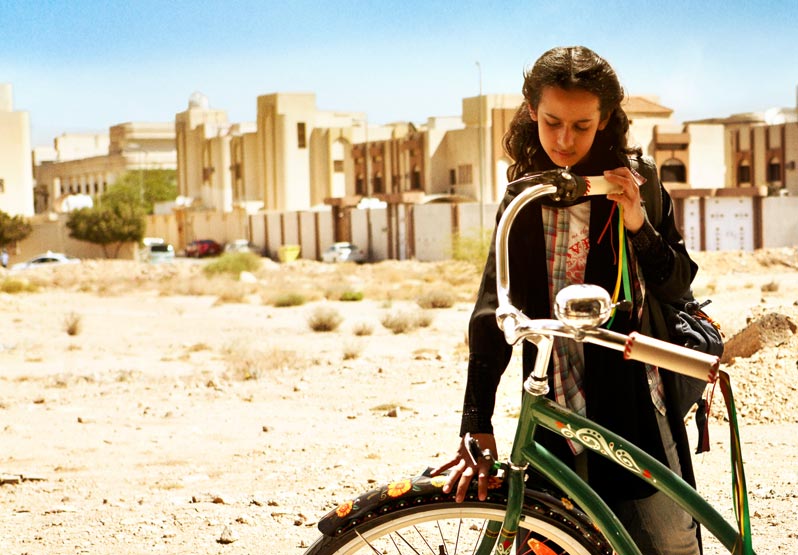Haifaa al-Mansour’s new film Wadjda  raises issues in gender parity that resonate across time and place as it traces one girl’s quest to learn to bicycle. I hopped on my trusty iron stead and sped down to the Renoir, Brunswick Square for an afternoon matinee of the film, risking lightening strikes and melting humidity levels on a stormy summer day.
raises issues in gender parity that resonate across time and place as it traces one girl’s quest to learn to bicycle. I hopped on my trusty iron stead and sped down to the Renoir, Brunswick Square for an afternoon matinee of the film, risking lightening strikes and melting humidity levels on a stormy summer day.
The eponymous star of the film, ten-year-old Wadjda (Waad Mohammed), a feisty schoolgirl with tom boy tendencies and a penchant for mixed tapes and converse sneakers, becomes set on cycling when she sees her friend Abdullah riding with the other neighbourhood boys. When Abdullah steals her headscarf and rides off with it as a prank, Wadjda vows to get a bike of her own so she can race him. Wadjda’s mother, who is going through a crisis of her own as her marriage unravels, is appalled when her daughter asks for a bike, refusing to even entertain the notion. She reminds her daughter that Saudi girls simply do not ride bikes-especially not nice ones with future marriage prospects to think about.
Without spoiling the bittersweet end of this touching coming of age story, Wadjda clearly lays out how deeply gender disparity is ingrained in everyday life in Saudi Arabia, cycling included.
Despite this set back, Wadjda remains determined to buy a bike-not just any bike, but the green cruiser that swooshed into town like a dream on the roof rack of a delivery truck. It is clear that if she’s going to buy the bicycle, she’s going to have to raise the funds herself. Wadjda’s picks up production as part of a bracelet making cartel, selling zip lock bags of contraband club colored bangles at her school. She also acts as paid go between delivering love letters and arranging romantic rendezvous. The cash still isn’t rolling in fast enough. Instead, Wadjda sets out win the money in a Qur’an reading competition.
The 2012 World Economic Forum Global Gender Gap Report put Saudi Arabia near the bottom of its scale for gender parity, ranking it 131 out of the 134 countries looked at. These conditions stem in part from the country’s adherence to an ultra-conservative interpretation of the Qur’an, resulting in restrictions on women’s rights across the board. Mobility is one area that is compromised. Women are not permitted to drive vehicles, and must have a driver chauffeur them to places including work. To ride a taxi, women must be accompanied by a mahram (male guardian). Riyadh, where Wadjda is set, is the only city where women can ride the bus and even then they must use a separate entrance and sit at the back.
In April 2013, restrictions on women’s bicycling and motorcycling were relaxed. The ban on cycling for Saudi women had been in place since 1990. Women are now permitted to cycle in designated areas, such as recreational centers. They must wear a full abaya, a black voluminous cape-like over-dress which stretches from head to toe, and be accompanied by a male chaperon. It is suggested that women do not cycling in places where men congregate to ‘”avoid harassment.”
Al-Yawm, a Saudi daily paper, reported “Women are free to ride bikes in parks, seafronts and other areas, provided that they wear fully modest dress, and a male guardian has to be present in case of falls or accidents.” Their account quoted an unnamed source from the Committee for the Promotion of Virtue and Prevention of Vice.
Cycling is not to be adopted by women for transportation, nor are women encouraged to take up competitive sport. The decision on cycling is yet to be reviewed by the Shura council, Saudi Arabia’s top advisory body. The ban on women driving cars remains intact.
Saudi Arabia is not the only place where women’s cycling is forbidden. From the mid-1990s until 2012, cycling was a fine-able offense for women in North Korea. In parts of Africa, the taboo against women straddling a bicycle is so strong that riding is inconceivable. In Iran, cycling is permitted but frowned upon. The 200o Iranian film The Day I Became a Woman, directed by Marzieh Meshkin, puts a women’s bicycle race in the center of a women’s attempt to break free of her controlling husband. Ayatollah Elm Alhuda, an Imam quoted in the Mohabat News during the 2012 Olympics, explained the typical Iranian stance against women’s cycling, stating “It is not a sin for a woman to sit on a bicycle saddle, provided she does so indoors or in her backyard…but if she cycles in public her movements and posture will lead to corruption and prostitution.”
The arguments against women’s cycling in Saudi Arabia and other areas where the practice is banned are not that different from those expressed when women’s cycling was first introduced in the West. Women’s cycling may not have been outlawed in the early 1890s, but social conventions certainly discouraged it ways that are comparable to the situation depicted in Wadjda. When Wadjda asks for a bike, her mother dismisses the idea outright and is dismayed that she should even consider cycling since it is not something girls do. The idea that respectable women shouldn’t bicycle was certainly expressed in the early days of cycling. Another scene showing Wadjda walking home from school alone, a construction worker yells out a sexualised comment, much like women complained men did when they went out walking, especially along the club row near Hyde Park in Victorian London. Victorian cyclists were targets for unwanted comments, harassment and even physical assault in some cases.
Wadjda coerces her friend Abdullah into letting her learn to ride using his bicycle. They sneak the bicycle up to a hidden courtyard on the roof of her house where she can practice in seclusion. This is reminiscent of the Victorian women who learned to ride at under the cover of night or in private gardens, free from the prying eyes of the public. When Wadjda’s mother catches her riding, an act made worse by the fact she has invited a boy over to the house, Wadjda panicks and falls off the bike. “I’m bleeding!” Wadjda cries out, to which her mother replies “Oh no, your virginity!” Turns out, it was just a scraped knee. Victorians shared this concern but did not put so boldly. Instead, 1890s anti-cyclists spoke of the dangers of saddles, vibrations, and physical contact with female anatomy.
Cycling is only one way that gender disparity touches women’s lives in Wadjda. Even before she asks for a bicycle, Wadjda’s mild disobedience and pre-teen rebellion, consisting mostly of blaring pop music in her room, wearing jeans and sneakers under her abaya, and questioning restrictions placed on her as a girl, raised eyebrows. This is, after all, a community where phones ring off the hook with gossip about which teacher has been caught with a ‘handsome thief’ in her bedroom and whose daughter still isn’t married off. Jokes between Wadjda and her mother about marry her off turn out to be uncomfortably close to the truth when the marriage of one of her 12 year old classmates to a 20 year old groom is announced in school.
The impact of gender disparity on the lives of adult women is apparent in Wadjda’s mother’s struggles. Wadjda’s mother tries desperately to cling to her failing marriage, keeping her hair long and investing in a glamorous red dress to distract her husband from his search for a second wife who will give him the son she has not been able to produce. When her driver quits, she nearly loses her job since women are not allowed to drive and she turns down another job because male and female employees freely associate with each other. After she explains to her daughter why they, as women, are absent from family tree displayed in their house, Wadjda adds her name to her fathers branch, only to find the sticky note cruelly pulled off and crumpled up because only sons count in family lines.
The film shows how women in influential positions reinforce gender disparity, and are even complicit in it, by accepting restrictions themselves and imploring young women to go along with them, from Wadjda’s mother who normalizes wearing the full abaya to the teachers who admonish students for reading fashion magazines and evacuate the school court yard when men come into view. These women, it turns out, have their own skeltons in their closet despite their outward adherence to social regulations.
The film itself is of note for being the first full length features to be filmed in Suadi Arabia by a woman. To accomplish this in a country where outdoor space is segregated by gender, al-Mansour directed scenes from inside a van alongside the set.
When asked by the Independent to react to the relaxation of the restrictions on cycling for Saudi women, Haifaa al-Mansour commented “Yes, that’s great, right? We should ne happy that changes like this are taking place. I know they seem like they are small and they don’t mean much, but it shows that attitudes towards women are changing, and women are getting more liberties, even if it is very slowly. There is still a long, long way to go, but hopefully things like this pave the way for bigger changes.”
Other Saudi women find the lifting of the cycling ban underwhelming. Twitter feed back suggests the weather in Saudi Arabia is not conducive to cycling, that the roads are not suitable for cycling, riding in an abaya is dangerous, and women didn’t want this ruling anyways-they’d rather have more meaningful rights, like the vote.
The relaxation of restrictions on cycling and critical success of Wadjda may not constitute a full blown feminist revolution in Saudi Arabia, but lets hope as al-Mansour suggests they are steps in the right direction.








